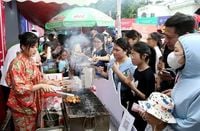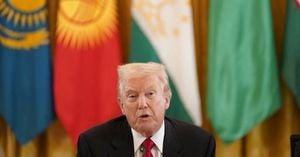From October 10 to 12, 2025, Hanoi’s historic Hoàng thành Thăng Long Heritage Center transformed into a dazzling crossroads of global culture as it hosted the first-ever World Culture Festival. This landmark event, organized by the Ministry of Culture, Sports and Tourism in coordination with the Ministry of Foreign Affairs and the Hanoi People’s Committee, brought together representatives from 48 embassies and international organizations in Vietnam, making it a truly international celebration.
For Hanoi residents and visitors alike, the festival offered a rare and vibrant opportunity to experience the world’s cultures without ever leaving the city. According to Dân trí, the festival featured 45 national cultural spaces, 34 food booths, 23 art troupes from both Vietnam and abroad, 12 book introduction units, and 22 countries participating in film screenings. The event’s sheer scale marked a record for the number of diplomatic missions involved, underscoring Hanoi’s growing status as a hub where civilizations meet and exchange ideas.
One of the festival’s most irresistible draws was its culinary showcase, where visitors could savor delicacies from five continents at surprisingly affordable prices. From French baguettes and pastries to Japanese sushi, Italian sausages, Mexican tacos and nachos, Malaysian curries, and Indian specialties, the festival’s food booths offered a whirlwind tour of global flavors. Dishes were prepared on site by skilled chefs, with most items priced at just several tens of thousands of Vietnamese dong—a modest sum for a taste of the world.
“I bought Korean rice cakes for 50,000 dong and a few Japanese skewers for about 90,000 dong. The prices are quite reasonable for the experience,” shared Trần Thùy Linh, a 21-year-old visitor, with Dân trí. She was delighted to find her favorite Japanese and Korean food stalls side by side, making it feel like a standing buffet of Asian cuisine. Linh noted, “The flavors are quite authentic, just like what I’ve had in Japan and Korea.”
The French booth, always a crowd favorite, highlighted the baguette—recognized by UNESCO as an intangible cultural heritage—as well as an array of classic pastries such as croissants, apple tarts, and macarons. “We brought the signature sweet pastries of France to the festival,” said Kim Thị Trang, a vendor at the French booth, who noted that the beautifully arranged display attracted many families and couples. Children and sweet-toothed visitors lingered over the tempting selection, with prices remaining accessible for most attendees.
Elsewhere, the Mexican food booth was abuzz with activity, led by chef Pato Munoz, who had been invited by the Mexican Embassy. “I have been in Vietnam for a year now. I really like the climate and the friendliness of the Vietnamese people,” Munoz told Dân trí. “At this festival, I’m serving two traditional Mexican dishes: tacos and nachos. They’re well-balanced, with starch, meat, and vegetables. I hope visitors enjoy my food and the cultural experience here.”
For many, the festival was as much about cultural immersion as it was about food. Visitors were invited to try on traditional costumes from countries like India and Vietnam, and the British booth drew crowds with interactive games and lucky draws designed to spark curiosity about British culture. Children had their own adventures, with a hockey activity set up especially for them, and some practiced for the festival’s closing performance, which promised to be a lively finale on the evening of October 12.
Nguyễn Văn Sĩ, who traveled from Đông Anh to attend, described his enthusiasm for the event: “I learned about the festival on TV, so I took the bus here at noon to experience the vibrant and colorful atmosphere of nearly 50 countries.” His sentiment echoed that of many festival-goers, who relished the chance to immerse themselves in a mosaic of global traditions and flavors.
Cooking demonstrations and hands-on workshops added another layer to the experience. Nguyễn Quốc Minh, a young attendee from Hanoi, recounted his first attempt at making traditional Ukrainian potato pancakes. “It was a very interesting experience. Compared to Vietnamese traditional dishes, it wasn’t too difficult to make, but the taste was quite new and special,” Minh told Dân trí.
The festival was not limited to food and costumes. Art, music, film, fashion, and fine arts all found a place in the bustling event. International film screenings introduced audiences to cinematic gems from Vietnam and abroad, held in the atmospheric setting of the Hoàng thành Thăng Long’s historic halls. Nightly performances, fashion shows, and even charity auctions rounded out the program, ensuring there was something for everyone.
Beyond entertainment, the festival carried a deeper message. With a theme emphasizing culture as humanity’s bridge and creativity as a universal language, the event promoted cross-cultural understanding and celebrated the diversity that enriches our world. According to organizers quoted by Dân trí, the festival was a key cultural diplomacy initiative for Vietnam in 2025, reflecting the country’s commitment to fostering international exchange and friendship.
Festival-goers also witnessed the inauguration of a new bell tower at Hoàng thành Thăng Long—a meaningful gift from the Hanoi Handicraft Association and Hanoi Craft Village, aimed at preserving and promoting the site’s heritage. The ceremony was attended by dignitaries including Deputy Prime Minister and Minister of Foreign Affairs Bùi Thanh Sơn, who in his commemorative speech highlighted the 80-year journey of Vietnamese diplomacy as one marked by courage, intelligence, and loyalty.
For three days, the Hoàng thành Thăng Long heritage site was awash in color, music, and the aromas of global cuisine. The event drew thousands, all eager to explore, taste, and connect. As families sampled Italian sausages, tried Indian snacks, and watched their children don traditional costumes or play hockey, a sense of unity and joy filled the air—proof that, even in a world of many differences, there’s plenty that brings us together.
As the festival’s final evening approached, children rehearsed for the closing performance, friends reunited across continents, and visitors lingered over one last bite or photo. The World Culture Festival left a lasting impression, not just as a feast for the senses, but as a testament to the power of cultural exchange in the heart of Hanoi.

![[Ảnh] Khám phá những trải nghiệm độc đáo tại Lễ hội Văn hóa thế giới lần thứ nhất](https://thumbor.evrimagaci.org/SSXUjz_YlysqMV2r75XN_Sp3Nz0=/200x0/tpg%2Fsources%2F3ac96fdc-3796-43e9-88bc-d74b75005070.jpeg)



